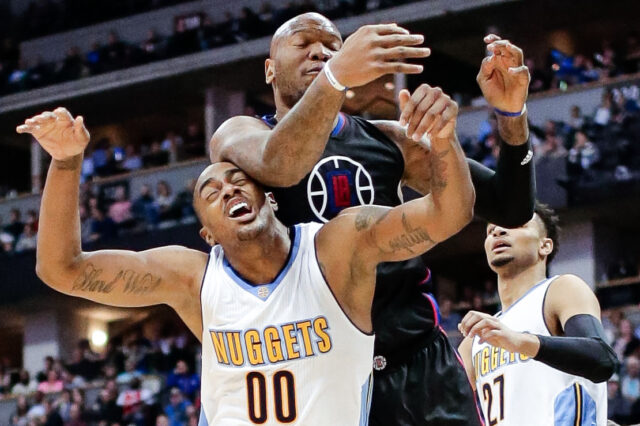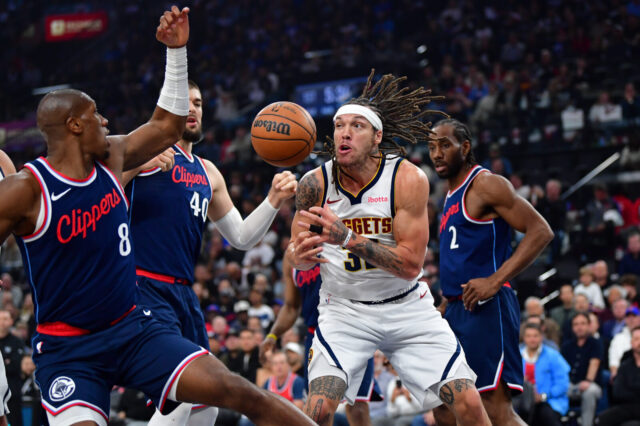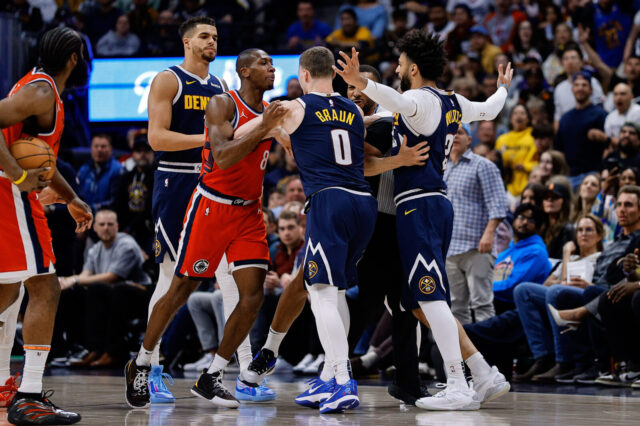“The road to hell is paved with good intentions”
Proverb: Saint Bernard of Clairvaux
When former NBA Commissioner David Stern retired in February of 2014 there was many an epic poem written lauding the erstwhile former NBA head. Even some that covered what many considered his "darkest" moment, the Tim Donaghy referee scandal in 2007. Stern was genuinely great for the League, and had his moments of bullying and controversy (the relocation of the Seattle Supersonics is a black mark on the NBA that it is yet to correct), yet, one particular controversy and apparent "failure" went unmentioned and seemingly erased from the NBA History books by disinterested NBA Media.
Two businessmen, one from Chicago and the other from Boston came together to become the first African American owners of a professional sports team in the United States. It was destined to be an ill conceived, poorly planned disaster that, in the end, did little to improve the standing of African American owners in professional sports.
The journey actually began with a phone call in 1985 that changed the course of Nuggets history.
"Big Red, I want to buy the Nuggets"
Red McCombs is and was arguably the best owner the Nuggets have ever had, with all due respect to Stan Kroenke. An owner that genuinely cared about the well being of the team and, quite literally, saved the Nuggets from financial ruin in 1982 after purchasing the team from a consortium of owners who were rapidly running out of money to run the team (including Team President/owner Carl Scheer).
McCombs swooped in, righted the financial ship, persuaded Vince Boryla to replace Carl Scheer as President and GM, and before you know it the Nuggets were in the Western Conference Finals against the Los Angeles Lakers in 1985.
On what is now a fateful day in the offseason of 1985, McCombs pal from Texas Sidney Shlenker made a phone call that proved the "Texas way" of doing business isn't always the best way. As McCombs told Irv Moss of the Denver Post in 2012: "Sidney said to me, ‘Big Red, I want to buy the Nuggets,’ " McCombs recalled. "I told him I wanted to continue building the asset, but he asked what I would take for the team. I figured what I thought the franchise would be worth in three years, and I doubled it."
To McCombs surprise Shlenker agreed to the price ($28 million according to McCombs) and the very next day they signed the papers at the Brown Palace Hotel in downtown Denver after what amounted to a half hour phone call. According to McCombs interview with Irv Moss, his wife was none too happy with him: "I didn’t want to sell the Nuggets, and I look back now and think it was the worst thing I ever did," McCombs said from his office in San Antonio. "Mayor (Federico) Peña asked me not to sell the team. My wife, Charline, got so angry at me it almost led to a divorce. She liked Denver, and I liked Denver."
So for the beginning of the 1985-86 season Sidney Shlenker, a brash, loud Houston businessman who made friends and enemies with equal aplomb took over ownership of the Denver Nuggets.
Flipping a house
There is a legitimate question as to whether Sidney Shlenker intended to keep the Nuggets long term or not. History and Shlenker's own behavior would indicate that he never planned on keeping his newfound investment beyond a date where he could maximize value. Indeed, Shlenker purchased the Nuggets for $28 million in 1985 which was double it's value at the point of sale. Good for the league, and it turned out to be financially good for the Texas businessman.
Sidney Shlenker made his money as a primary investor in a company that would book events for the Houston Astrodome. He was key in bringing big acts to the “8th Wonder of the World” (including the Bobby Riggs/Billie Jean King “Battle of the Sexes” in 1973). Later he bought in as a part owner of the Houston Rockets in 1982. When he sold his part ownership of the team in 1985 he turned to his old friend and sometime business partner Red McCombs to purchase the Nuggets for a price McCombs couldn’t refuse.
The brash businessman was far from a bad owner. In fact Shlenker was often at McNichols Sports Arena meeting and greeting fans. In 1986/87 he poured $12 million of his own money into bringing the 12 McNichols (Big Mac) up to date, which included improved scoreboard and seats. Despite having his eye on maximizing and flipping his investment, Shlenker managed to deeply care about the Nuggets and gave general manager Pete Babcock (who replaced Vince Boryla) the leeway he needed to manage the team (the contract he gave Blair Rassmussen and drafting Jerome Lane simply because he broke a backboard in college notwithstanding)…but rumblings and rumors that Shlenker was looking to sell began in earnest in 1988. Like flipping a house before that sort of thing became the "in" thing to do, Shlenker had his eye on maximizing his initial investment.
Meanwhile, an aging Nuggets roster that peaked in the 1987-88 season (with a 54 victory Midwest Division winning team) was on a steep decline into barely hanging onto mediocrity. Alex English was getting older. Lafayette “Fat” Lever couldn’t stay healthy and the patchwork of Walter Davis (1988) and Tim Kempton (1989) were just band aids over an aging team. A rebuild was coming for the Denver Nuggets and head coach Doug Moe knew it … and was actively looking for a fresh, younger Denver Nuggets team…
David Stern and the eye on history
When former league Lawyer and Assistant Commissioner David Stern took over the NBA in 1984 he had to clean up low ratings and the NBA’s huge image problem because of all the drug scandals in the late 1970’s and early 80’s (including the Nuggets only true superstar David Thompson).
By 1989, through the help of Magic Johnson and Larry Bird the NBA was riding high, with most of the lingering drug issues dispelled. The NBA had a new Champion, the Detroit Pistons and was merging into a new era, dominated by Michael Jordan and soaring league popularity. Stern forged a partnership with Atlanta-based Turner Sports which was owned by CNN head Ted Turner (who then owned the Atlanta Hawks) and was run by Robert Wussler Jr. This alliance (which exists even today) allowed the NBA to market onto cable at a VERY early stage and played a significant role in the boom of NBA popularity toward the end of the decade.
Stern also had his eye firmly on placing the NBA in the history books with progressive cultural matters. A lifelong Democrat, Stern was quite aggressive in staking out a wide swath of social and progressive causes including making Martin Luther King day a part of an NBA feature since it's inception as a National holiday in 1988. This played a key part in Stern's push for the NBA to become the first professional sports league to have African American ownership.
Whereas African Americans had, by 1989, made inroads in many avenues of professional life, ownership remained elusive. Quite simply it's not significantly better in 2016. Yet, back in the late 80's that great ceiling at the top of sports franchises … ownership … seemed hardest to crack. For a league who's majority of players was (and is) African American it was increasingly becoming untenable and NBA Commissioner David Stern knew it.
In 1988, Boston-based African American business man Bertram Lee attempted to buy the San Antonio Spurs for $50 million but couldn’t close the deal. Lee was a well-respected entrepreneur in the northeast who owned a television station in Boston. It was this type of approach and aggressive pursuit of ownership that Stern was looking for, and he never forgot Lee’s pursuit of the Spurs.
By 1989 rumors that the NFL was looking to add African American/minority ownership to their stables reached David Stern. The NBA was always the first in cultural diversity since he became Commissioner and Stern wasn't about to be beat by the NFL.
"We had a lot of credibility coming in the door …"
Sidney Shlenker made the decision to sell the Nuggets. He felt, after improvements to Big Mac (which included restaurant facilities and a state of the art scoreboard) that now was the time to maximize his investment and sell out. There wasn't a tremendous amount of interest in the Nuggets, however. Despite the Nuggets success during the 1980's the season ticket base by the 1988-89 season was rather tepid, even though the team had won 54 games the season before.
Shlenker received a call from an ownership group near the end of the 1988-89 season. Lead by the partnership of Chicago lawyer and sports executive/real estate developer Peter Bynoe. Bynoe had spent the previous 10 years closely aligned with the Chicago White Sox and helped out tremendously in securing financing to build new Comiskey Park. His partner was Bertram Lee, the man who had tried unsuccessfully to purchase the Spurs the year before.
Shlenker met with the men. As Bynoe said to the publication Black Enterprise: "We had a lot of credibility coming in the door and the people who talked to about structuring financing knew that." So as the two businessmen left Denver with a veritable ream of paper and information they set out to buy the Nuggets from Shlenker and make business history. Later on in the process,on a small scale was Tennis legend Arthur Ashe and former DNC Chairman Ron Brown came aboard as smaller investors. A dream team of African American potential ownership.
It was later revealed that NBA Commissioner David Stern, upon hearing that Shlenker was having trouble selling the team encouraged Lee and Bynoe to approach Shlenker. Even more, Stern also encouraged Ashe and Brown to come in to the prospective ownership group. Stern's fingerprints, in fact, were all over the prospective deal.
A deal was struck. The Bynoe/Lee group would buy the Denver Nuggets, debt free, from Sidney Shlenker for $65 million free and clear. A deal that was almost too good to be true. Shlenker nearly tripled his initial investment when he bought the Nuggets from Red McCombs on a 30 minute phone call in 1985 and the NBA would be officially the first professional sports league with African American ownership.
On July 12, 1989 the deal was announced at the Waldorf Astoria in New York. The rationale provided by the NBA was that an announcement of such historical and national significance needed to be announced at the seat of the NBA headquarters, but it succeeded to make people in Denver scratch their heads. Additionally, minority partner Arthur Ashe pointed out the cultural impact of the deal “It is a significant event in sports history, however it won’t be much of a novelty soon.”
Why were they announcing the deal in New York? One Denver source who was around at the time told me “That’s the moment I began thinking that the Commissioner was more concerned with making history than the well-being of the Denver Nuggets”.
Yet, everyone was elated that the Nuggets were making history with their new owners. Shortly after the presser in New York, the new owners held a press conference in Denver. There Bertram Lee (who took the lead in the presser) introduced Dave Checketts as the new Nuggets team President. Checketts had revived the moribund Utah Jazz in the 1980’s but had left the Jazz after a dispute with Jazz owner Larry Miller in 1988. Checketts and Bynoe/Lee vowed to keep head coach Doug Moe in place as well as then General Manager Pete Babcock.
After some initial hurt feelings, history was made and the future looked bright for the Nuggets and things looked to be heaven…for awhile, at least.
Where is the money?
Plaudits showered Commissioner David Stern. The spectacle of the Waldorf press conference gave the Commissioner the cultural cache he had been striving for since he became head of the League five years before. It felt, for all intents and purposes, like a culmination. In a very real fact that is beyond dispute, the NBA is the most progressive league in professional sports largely due to the advances that David Stern championed during his tenure. However, shortly after Bynoe and Lee spoke to the Denver media in July of 1989, privately things began to unravel.
Things started going sideways for the Bynoe/Lee coalition when they couldn't make Shlenker's first deadline to close the sale, unbeknownst to the general public who was kept blissfully unaware that things weren't what they seemed on the outside. Sidney Shlenker was still listed as owner as the months trudged on and as things began to leak out through the media an uneasy reality struck the NBA and the Denver public…The new Nuggets ownership situation was in trouble. Desperate trouble.
They simply didn't have the money to purchase the team.
As out and out chaos began to envelop the NBA and the new prospective owners, elements of the Bynoe/Lee coalition began to abandon ship. As the financial disaster loomed Arthur Ashe and Ron Brown withdrew their names from the ownership group as it became clear either Bynoe or Lee didn't have the money to buy the team that one or both of them said they did.
In October of 1989, faced with a final deadline to make capital call to produce financing for the initial $65 million purchase, General Manager Pete Babcock was left to break the bad news, according to the New York Times: ''Sidney feels bad about not being able to make the deal with Peter Bynoe and Bertram Lee,'' said Pete Babcock, a Nuggets official. ''He felt very strongly about the issue of minority ownership, but he also faces the financial reality of making a decision whether to move in another direction. He extended the closing date three times and today it ran out.''
A week before Shlenker put a halt on the purchase, David Stern confidently told reporters that the deal would be done and that he would be submitting a vote to the owners via Telex. The reality was it wasn't even close. When Shlenker cancelled the deal, Dave Checketts checked out of the ownership group. The looming financial disaster was greatly concerning to him and it was tasked to him to scramble to find investors around the country. Everything was falling apart and the dream of the first African American owners in professional sports seemed to be fading.
A desperate David Stern was left scrambling to save the deal. Why did he announce the sale in a big press conference in New York if he wasn't aware if Bynoe and Lee could afford the team? It seemed … rushed. People in Denver were left exasperated and embarrassed.
The story continued, however, and the next two years became calamity after calamity.
(the story continues in Part 2)


